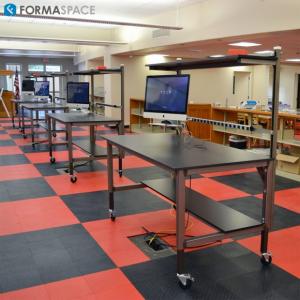Investing in New Infrastructure to Build Successful K-12 Education Programs
As we look forward to a return to normality post the pandemic, now is the time to make new investments in America’s education programs.
Throughout 2020, K-12 school programs found themselves thrust into the crosshairs of high-profile controversies as public health scientists and, government officials, and educational administrators grappled with the challenge of how to cope with unprecedented challenges of the coronavirus pandemic.
Parents, teachers, and students alike have had to cope with sudden school closures, improvised classroom instruction conducted online via Zoom, a delayed return to in-class instruction under strict social distancing guidelines, as well as, in many cases, schools reverting to online instruction when coronavirus infection levels began to rise too quickly.
Four Preliminary “Lessons Learned” From Covid-19 School Closures
The sudden closure of K-12 schools during the spring of 2020 shined a harsh spotlight on five structural shortcomings in the American education system:
1. Unequal Access To Study Areas, Computers, And Broadband Internet In American Homes
The sudden switch to online instruction for K-12 students revealed widespread resource disparities in the homes of America’s young students. For example, rural students living beyond the reach of broadband Internet networks either couldn’t participate in online instruction or had to drive to wireless emergency “hotspots” set up by local school districts or library systems to get a working Internet connection. Online instruction also revealed students in poor households either had no fixed address or lacked a suitable place to work (e.g. a desk) and a computer at home. (School psychologists also noted that students participating in online classes observed huge disparities in living conditions among their peers, leading some students to feel shamed by their limited circumstances.) Finally, many of the nation’s estimated 7 million disabled students (14% of the student population) faced additional barriers when receiving online instruction.
2. The Phenomenon Of Disappearing Students
K-12 school systems across the country found student attendance unexpectedly dropped off in 2020, with many districts reporting a 4% or more decrease in the primary and secondary student population. Did the students simply drop out when schools moved to online classrooms? Further complicating the issue of disappearing students is the students who nominally attended online classrooms but failed to show any effort in completing class assignments. Determining where the students went and what can be done to bring them back into the education system is a major challenge facing school administrators. It also creates an unwelcome income challenge for school districts – as many are funded by a formula based on student attendance.
3. Meeting Learning Objectives And Conducting Realistic Assessments And Exams
This brings us to the third major issue with the sudden switch to online classes: are students able to keep up with the normal pace of learning? Many teachers and administrators feel the answer is no; many K-12 students have fallen behind in their learning objectives compared to previous cohorts receiving in-class instruction. The issue, however, is further clouded by teachers having to improvise new ways to assess student progress in an online teaching environment. Standardized tests have been affected as well, with many exams having simply been waved off this year or highly truncated, such as this year’s shorter ACT exam or the abbreviated tests evaluating high school students’ AP credits.
4. Many Parents Can’t Work If Their Children Are Not At School During The Day
The sudden, unexpected closure of schools also put many working parents in a bind throughout 2020. If their children couldn’t go to school, many parents found they could not go to work. Childcare is too expensive for many working-class families, and even for those who can afford it, it’s not only an expensive financial burden, it’s also difficult to arrange on short notice. As a result, many parents with jobs that did not allow them the opportunity to work at home (and supervise their kids) had to scramble for child care at home or quit their job.
5. Everyone Is Stressed Out To The Limit
At the risk of stating the obvious, nearly everyone is stressed out, whether due to extended home lockdowns, fear of the virus, sudden school closures, economic disruptions, unemployment, financial difficulties, or any of the other numerous challenges that have arisen in 2020.
Addressing The Challenges And Opportunities In The Post-Covid World Of K-12 Education
The Covid pandemic brought radical change to K-12 schools in 2020 but, as we look ahead, the highly anticipated availability of vaccines in the near future means that now is the time to plan for the future of post-Covid education programs at K-12 schools.
Closing The Attainment Gap To Achieve Better Outcomes In K-12 Education
Based on the latest information from public health authorities, it looks like we can be cautiously optimistic about K-12 schools returning to more normal conditions by the start of the fall 2021 academic year.
By that time, if all things go right, a significant portion of the US population will have been vaccinated – particularly frontline healthcare workers and vulnerable populations such as the elderly or those with underlying health conditions – to create a protective Covid-19 “herd immunity.”
Assuming that is a realistic timetable, now is the time for school districts, state governments, and the federal government to make strategic investments in schools.
In the words of the President-elect, we need to “build back better” – to address the issues mentioned above that were revealed during the Coronavirus pandemic as well as meet the challenges posed by major demographic shifts that are forecast change the face of K-12 student populations in the near future.
Where should we begin?
One place to start is to identify best practices, such as the 2018 study from Education Week’s annual Quality Counts report card that identified five common strengths among the top-ranked school districts in the US.
The report found the most successful K-12 schools with the best outcomes shared these characteristics:
1. Robust Economic Environments
Parents tend to earn more in top-ranked states, many of them nestled in the Northeast and Mid-Atlantic.
2. High K-12 Test Scores, Grad Rates
Top performers set a high bar for teaching and learning, and they’re aggressive on accountability and school turnarounds.
3. Relatively High Spending On Schools
Per-student funding tends to be higher in top-ranked states, but it’s not always spread equitably among all schools.
4. Strong Early Childhood Climates
Well-educated parents and broad access to quality preschool are a plus.
5. Widespread Postsecondary Participation
Leading states do well in getting students into and through college.
Critics will immediately point out that “of course, it is easier to achieve better outcomes with students from higher-income families,” and to them, we say, we do not disagree!
Read more...
Julia Solodovnikova
Formaspace
+1 800-251-1505
email us here
Visit us on social media:
Facebook
Twitter
LinkedIn
Legal Disclaimer:
EIN Presswire provides this news content "as is" without warranty of any kind. We do not accept any responsibility or liability for the accuracy, content, images, videos, licenses, completeness, legality, or reliability of the information contained in this article. If you have any complaints or copyright issues related to this article, kindly contact the author above.



